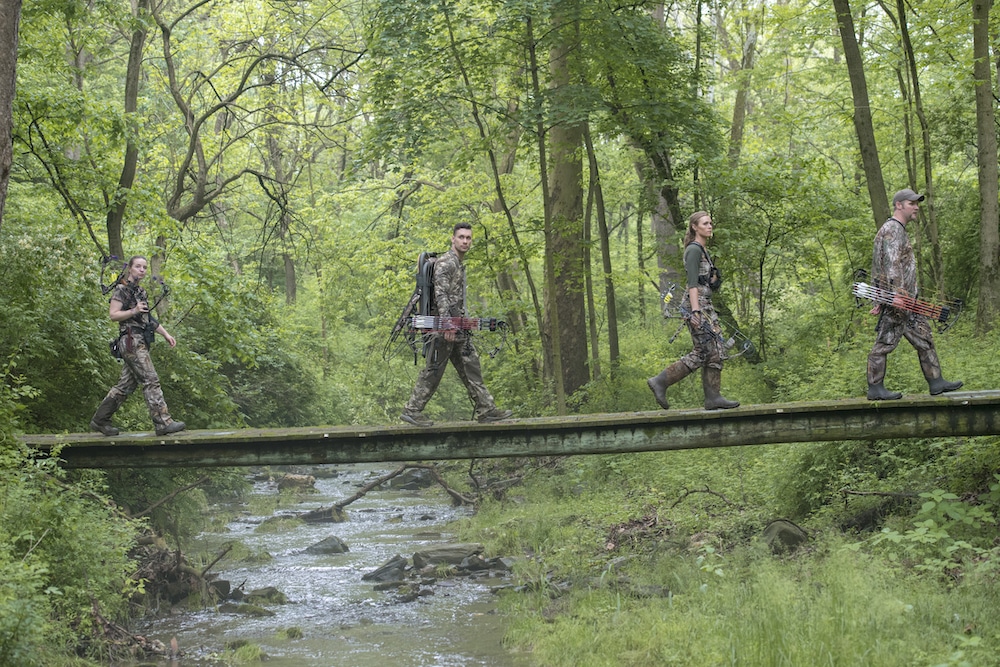Outdoor enthusiasts often encourage people to “forget the forecast.” It’s a clever way of saying to enjoy the outdoors regardless of the weather. With so many variables at play, waiting for the right conditions would keep many people inside. But does the same logic apply when it comes to bowhunting? That depends. Weather should always be top of mind for bowhunters. It affects animal movement, personal safety and meat spoilage times.
Deciding whether to hunt or not in certain weather is mostly personal preference. However, certain conditions require greater preparation, and at times, a decision to stay inside can be for the best. This preparation is important enough to note that the National Bowhunter Education Foundation has an entire section dedicated to preparing for weather conditions in its bowhunter education curriculum.
Bowhunting in the rain can dramatically change your day in both good and bad ways. Here’s a look at the pros and cons of bowhunting in rainy conditions.
Quiet Conditions
My 2021 elk season started out frustrating. Hot, dry conditions made it sound as if I were smashing a bag full of chips with every step on the forest floor. The crunchy ground made it impossible to do anything but sit patiently and hope an elk walked by. But then it rained. Wet weather changed everything. The rain drenched the grass, leaves and pine needles, making it possible to sneak silently through the forest. The morning after the wet weather moved in, I snuck up on two bulls fighting in the trees, an encounter that would have been impossible the previous day.
Concealed Movement

Hunting in the rain can help conceal your scent.
Photo Credit: Bowhunters United
Rain helps conceal movement because it creates movement. As raindrops fall, they move branches and leaves, which can be just enough to mask your movements, including drawing your bow.
Scent Killer
The smell of fresh rain is so powerful that you’ll find it replicated in scented candles and home air fresheners. But rain isn’t just an odor; it’s an odor-killer. Rain helps mask human scent. It can wash away scent trails and make it more difficult for deer to detect human presence.
Changing Wildlife Movement
Bowhunters targeting ungulates like elk and deer typically expect the majority of animal movement to occur during the early morning hours and just before dark. That’s when animals are most active feeding and moving. However, weather patterns can change traditional movement. Light rain doesn’t typically cause animals to run for cover. Heavy rains will usually make wildlife hunker down. However, after a downpour, many animals will be up and moving, looking for food. And I’ve had some incredible rainy days in the field when the animals seemed to be moving all day long.
Less Human Pressure
Remember the advice, “forget the forecast”? Well, not everybody listens. Rainy days keep a lot of hunters home. If you’re not afraid of getting a little wet, you might find yourself alone in the field.
Added Gear Requirements
Hunting in wet weather requires the right gear. You’ll need a waterproof jacket, pants and boots. Good rain gear can get expensive, and many materials are pretty noisy. But sitting or hiking in wet weather isn’t very fun either. Getting wet isn’t only uncomfortable; it can be dangerous. Hypothermia can happen in cold conditions, like downpours. And even if the situation isn’t dangerous, shivering can give away your position or make it impossible to hold your bow steady.
Dangerous Lightning
There’s a big difference between bowhunting in a rainstorm versus a thunderstorm. Lightning is dangerous, and you don’t want to risk getting caught in the field in it, especially in a treestand. When the forecast is calling for lightning, you should probably stay home. If you find yourself caught in an unexpected thunderstorm, leave the field as soon as possible if you can. Get out of the treestand immediately. Get away from any other metal. Avoid tall objects and fence lines.
Washed-Out Blood Trails

Use a blood trailing dog to make sure you can find the trail if it gets lost in the rain. Photo Credit: John Hafner
Rain hides human scent, but it also washes away blood trails. Often blood trails play a crucial role in the recovery of downed game. If you plan to hunt in the rain, it might be a good idea to have a blood-tracking dogon standby in case you take a shot — if using one is legal in your state.
Conclusion
Whether you bowhunt in the rain is up to you, but there are always some important considerations. Check the forecast every day and look into the specifics. A drizzle is different from a downpour, and you’ll want to stay home if lightning is expected. Bring the right layers. Pack extra clothing in the truck for a quick change at the end of the day in case you get wet. Make sure you have flagging tape in your pack. Rain will wash away a blood trail fast, but flagging tape will stay.
Bowhunting in the rain can provide a lot of opportunities. If you can handle a little wet weather, you might be rewarded with a day you won’t forget.